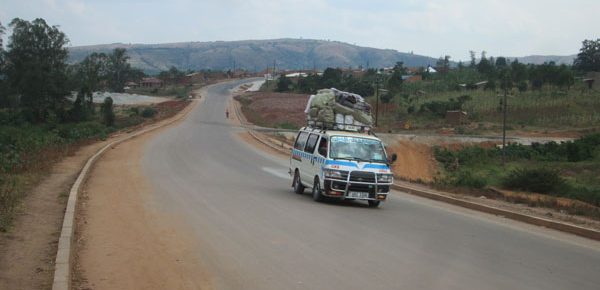Home > News >New Mirama Hills road changes Ntungamo life

New Mirama Hills road changes Ntungamo life • 2017-08-14
The newly constructed Ntungamo-Mirama Hills road and Mirama-Kagitumba One Stop Border Post (OSBP) facility have brought relief transporters and trans-boundary traders, travellers and the residents of Ntungamo district.
The 37 kilometer road passes through Sub counties of Ntungamo, Ruhaama, Rweikiniro and Ruhaama East, and connects Uganda to Rwanda at Mirama-Kagitumba.
Mirama-Kagitumba was in 2015 upgraded to OSBP. DFID funded construction and establishment of facilities needed for the new faster cargo and passenger clearing system.
Travellers and transporters had over decades braved potholes and dust, and delays and high costs of transport that come with using a murrum road. The carriageway is 7 meters wide. Kafunjo, Ruhaama and Kakukuru trading centres have been given 2.5 meters wide parking lanes.
Works to upgrade the Mirama Hills Road commenced in October 2014 and were launched by President Yoweri Museveni. The UK’s Department For International Development (DFID), through TradeMark Africa, contributed 50 per cent of the cost; the rest of the funds came from Government of Uganda, through the Uganda National Roads Authority The total cost of the road is approximately USD40m.
The progress of the road construction is now over 90 percent complete. UNRA’s Eng. Ian Bakiza, who is the project manager, says “We have completed over 90 per cent of the road works. Compensation issues that had delayed us have all been resolved.”

Better. Mirama- Kagitumba One Stop Border Post has facilitated clearing services.
The new road has already attracted a lot of business operations. Buses, taxis and cargo vehicles are using it. New businesses have come up in centres like Sofia, Kafunjo and Ruhaama.
The cost of transport has gone down with the increase in number of taxis and motorcycles. Hitherto empty road side houses are now occupied and stalls are coming up along the road stretch.
The four main roads leading to and outside Ntungamo municipality: Ntungamo-Kabale (75 km), Ntungamo-Rukungiri (50 km), Ntungamo- Mbarara (64 km) and Ntungamo –Mirama Hills (37km) are all now tarmacked.
Small and large scale farmers in the area can conveniently send goods to market and boost their incomes. “Construction of the road has reduced on the time we have been spending travelling to Ntungamo town. It has reduced from an hour to 30 minutes. The dust is gone. Traders from as far as Busia have started coming here for produce business,” says Mr Gordon Atuheire, businessman in Sofia (Uganda-Rwanda border) town.
Stores for beans and maize (grown by Ugandans and Rwandans on the border) in Sofia and Kafujo centres have increased because area is now easily accessible by traders. “Developments coming up. There are plans to create Kafunjo-Sofia Town Council. Three fuel stations being established. We have five maize milling machines in Kafunjo. People, especially from Rwanda who go to Kawempe (Kampala) for posho will no longer be going there; they will stop here,” says Mr James Turyahikayo Habineza, NRM chairman Ruhaama East Sub county.
Mr Hebert Tugume, a taxi driver, says they have reduced transport charges and vehicles no longer suffer mechanical breakdown. “I have been driving on this road for eight years; we were suffering because of dust. I was washing the mini bus every day. Now I don’t need to wash it every day; it takes a while. There have been only two minibuses but today we have five. We used to charge Shs 20,000 from Mirama Hill border to Mbarara town, we now charge Shs 10,000. Vehicles no longer get mechanical breakdown,” says Mr Tugume.
Ms Teddy Aheirwe, a resident of Rwera, says transport costs have reduced and travelers negotiate because vehicles and motorcycles are now many. She adds that there are now four Trinity and Jaguar buses plying route; they pass in their area at 8 am and 11 am heading to Kampala and Kigali.
“We yearned for construction of this road and finally it came; people have started benefiting, they have started erecting stalls on the roads and getting money from passing vehicles. Transport has become easy and we hope this will go on. People like me who normally go to Rwanda for trade it’s even easier with establishment of (one stop) border post, businessmen are enjoying, it’s only those who do not have what to sell that will really miss out,” says Mr Meshach Kahinda Rweikiniro Sub county chairperson.
Ntungamo LC5 Chairman Mr Denis Singahanche says with such road infrastructure in the district the residents have no reason to cry of poverty. “I have been telling my people to make sure they have what to put on market; with this road connection we have got as the district only people who do not work will remain poor. I had never seen a stall of anything along Ntungamo-Mirama Hill road, but now I can see them at Rwengoma, there are stalls at Kakukuru and Kafunjo,” says Mr Singahanche.
Mr Jacob Kafureka; Mayor Ntungamo Municipality, says construction of the road has eliminated dust in town. Part of the contract work was construction of the 1.2 km section of Kaguta Road in Ntungamo Town.
Mr Kafureeka says, “Much of the traffic was passing through Ntungamo to Kabale and Katuna because they could not use the road, but now that its constructed businessmen have even started reaping. There are more people staying overnight especially truck drivers; lodges, hotels bars and other businesses are being boosted.”
Mr Francis Twesigye, Ruhaama Sub county chairperson, says construction of the road came after 40 years but better late than never. “The construction was first promised by Amin in 1975. It was not done until 2014. Travelling to Rwanda is now easy, the border will be busy. Many people are yet to establish businesses but what I am anticipating is that this will be the busiest road in Ntungamo,” says Mr Twesigye.
The Manager Customs (URA) for South Western region Mr Sylvester Kiwanuka says with Mirama-Kagitumba OSBP, border control management has improved and clearing passengers and cargo is now faster. The OSBP facilities were opened on December 3, 2015.
The OSBP has officials from various government agencies, these include: immigration workers who handle passengers, revenue officials who are in charge of collecting taxes and border control, national bureau of standards officers who are charged with verifying quality of goods being transported, police who are charged with enforcing law and order and ministry of agriculture officials who track movement of livestock.
Before establishment of OSBP system, cargo and passengers going to Rwanda would first be cleared from Ugandan side and after that process they would move to Rwandan side and where the country officials would repeat the same clearing procedure.
Besides, various government’s agencies were scattered in different locations and structures. With OSBP system they are all under one roof.
“We were working under Africa Community Customs Management Act 2014, so there was duplication of work on both sides. This came with delayed clearing, the cost of doing business was high because of spending longer to clear cargo, and the most wanted revenue would take longer to get into government coffers because of delayed processes,” says Mr Kiwanuka.
He adds, “In the new system all agencies are housed under the same roof. One moves from one counter say of immigration to the next for URA. In the past you would move from immigration office in one building and go to another building for URA services.”
Travellers entering Rwanda (from Uganda) move directly to the clearing offices on the Rwandan side. However, their first contact official is a Ugandan who checks their documents and hands them (travelers) over to Rwanda officials for further clearance before they proceed. The same happens for travellers from Rwanda side; they move directly to Ugandan side but their first contact official is Rwandan.
Source: Daily Monitor Uganda

